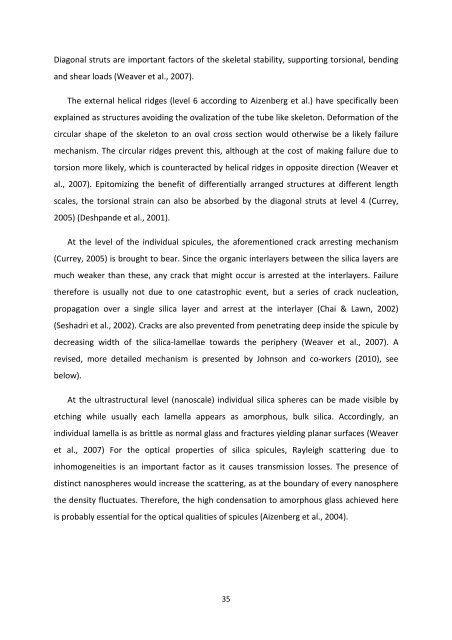MASTER THESIS Biomimetic potential of sponge ... - IAP/TU Wien
MASTER THESIS Biomimetic potential of sponge ... - IAP/TU Wien
MASTER THESIS Biomimetic potential of sponge ... - IAP/TU Wien
Create successful ePaper yourself
Turn your PDF publications into a flip-book with our unique Google optimized e-Paper software.
Diagonal struts are important factors <strong>of</strong> the skeletal stability, supporting torsional, bending<br />
and shear loads (Weaver et al., 2007).<br />
The external helical ridges (level 6 according to Aizenberg et al.) have specifically been<br />
explained as structures avoiding the ovalization <strong>of</strong> the tube like skeleton. Deformation <strong>of</strong> the<br />
circular shape <strong>of</strong> the skeleton to an oval cross section would otherwise be a likely failure<br />
mechanism. The circular ridges prevent this, although at the cost <strong>of</strong> making failure due to<br />
torsion more likely, which is counteracted by helical ridges in opposite direction (Weaver et<br />
al., 2007). Epitomizing the benefit <strong>of</strong> differentially arranged structures at different length<br />
scales, the torsional strain can also be absorbed by the diagonal struts at level 4 (Currey,<br />
2005) (Deshpande et al., 2001).<br />
At the level <strong>of</strong> the individual spicules, the aforementioned crack arresting mechanism<br />
(Currey, 2005) is brought to bear. Since the organic interlayers between the silica layers are<br />
much weaker than these, any crack that might occur is arrested at the interlayers. Failure<br />
therefore is usually not due to one catastrophic event, but a series <strong>of</strong> crack nucleation,<br />
propagation over a single silica layer and arrest at the interlayer (Chai & Lawn, 2002)<br />
(Seshadri et al., 2002). Cracks are also prevented from penetrating deep inside the spicule by<br />
decreasing width <strong>of</strong> the silica-lamellae towards the periphery (Weaver et al., 2007). A<br />
revised, more detailed mechanism is presented by Johnson and co-workers (2010), see<br />
below).<br />
At the ultrastructural level (nanoscale) individual silica spheres can be made visible by<br />
etching while usually each lamella appears as amorphous, bulk silica. Accordingly, an<br />
individual lamella is as brittle as normal glass and fractures yielding planar surfaces (Weaver<br />
et al., 2007) For the optical properties <strong>of</strong> silica spicules, Rayleigh scattering due to<br />
inhomogeneities is an important factor as it causes transmission losses. The presence <strong>of</strong><br />
distinct nanospheres would increase the scattering, as at the boundary <strong>of</strong> every nanosphere<br />
the density fluctuates. Therefore, the high condensation to amorphous glass achieved here<br />
is probably essential for the optical qualities <strong>of</strong> spicules (Aizenberg et al., 2004).<br />
35

















